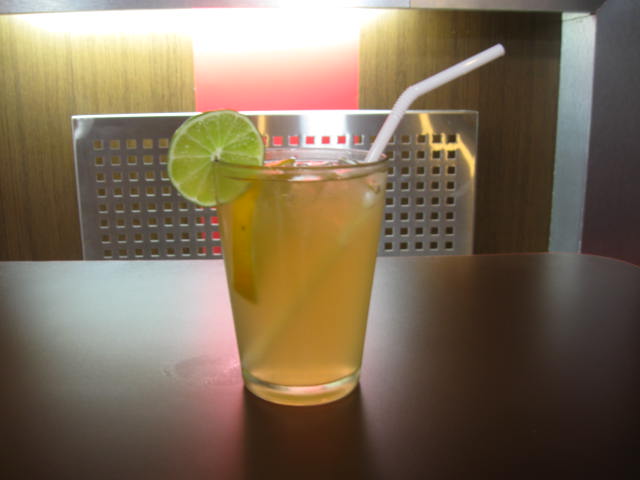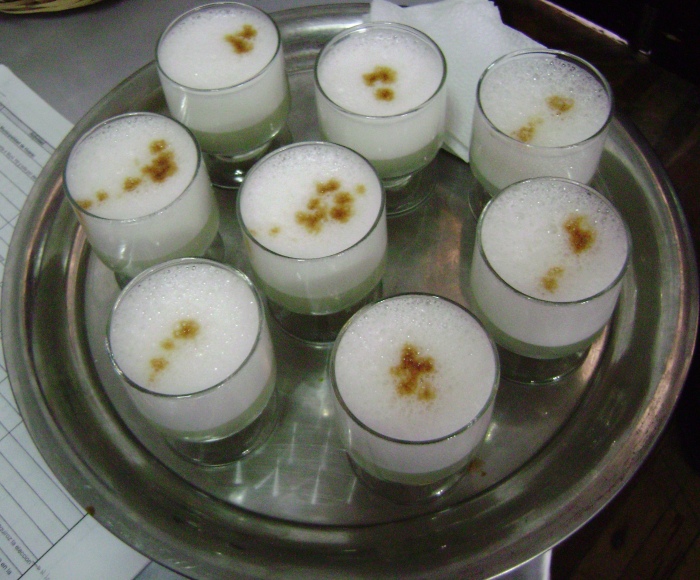Today it’s Peruvian Independence Day and for this occasion we’ll make today a theme day. But let’s not get ahead of ourselves, one post at a time. In this one we’ll discuss the national strong drink of Peru called pisco, the so called pisco wars and the recipe for the 2 most common cocktails that can be made with this drink: pisco sour and chilcano de pisco. Since it might be hard to find the real Peruvian pisco in some countries, we recommend you try Italian grappa or another grape distilled spirit as a replacement. Not quite the same thing, but what other options do you have if you still want to honour the Independence Day with a typical Peruvian cocktail?
So pisco is distilled from grapes and the alcohol percentage is usually slightly over 40%. The word pisco originates from Quechua, in which pisku it’s the name of a small bird. Because this bird was very common in a certain valley in Peru, this valley was named Pisko and it’s residents Piskos. The people from this valley were skilful potters that also produced the jars in which liquor was stored. These jars also got the name piskos and the last step was the liquor itself to be called pisco.
The oldest written testimony of this distilled grape wine dates back from 1613. A man called Pedro Manuel The Greek left 30 big bottles of pisco and 30 smaller ones in his will. Why is this such a known fact you ask? Well since Peru and the Chilean neighbors have been caught up for years in a legal conflict known as the pisco wars. Both countries claim the drink, that unlike for example cognac doesn’t have a protected origine. Legally it could not be proven without a doubt yet, but Peru clearly has the advantage.
The oldest map of Peru (from 1574) already had a port named Pisco on it, south of the current capital Lima. Written documents from the early colonial days show the big amount of grapes, wines and piscos in the area. Also, in the 17th century there’s already mentioning of the port, a city, a valley and a river by the name of Pisco in current Peru. The evidence Chile is bringing in to claim the brand name is weak. In the Chilean Valle de Elqui is a village named Pisco. However, the original name was Las Gredas and it wasn’t until 1936 that the name was changed into Pisco Elqui to support the case of South America’s number one wine country.
Anyway, a drink that’s worth to go through this much trouble, must be a good one right? Well you won’t be dissapointed. Pure pisco is pretty hardcore, but with a refined taste. Still most Peruvians chose to mix this drink in a cocktail. Pisco sour is probably the most well known, but chilcano de pisco is a very nice alternative. Salud!
Chilcano de pisco
60 ml pisco
120 ml ginger ale
half a lime
Ice
Preparation:
Fill up a long drink glass with ice cubes. Poor the pisco over the ice. Now squeeze the limes on top of that. Fill it up with the ginger ale and you’re done.
Pisco sour
60 ml pisco
20 ml sugar and water
30 ml lime juice
1 egg white
8 ice cubes
cinnamon
Preparation:
Put the pisco, sugar and water, lime juice and egg white in a shaker. Shake long and hard. Then add the icecubes and shake a little bit more. Serve it in a cooled glass and finish the drink with some cinnamon on top.
In case your pisco party was little too much fun, we have two typical Peruvian dishes for you that are known to cure hangovers. You find the recipes here:
Aguadito de pollo (chicken soup)
Cerviche (raw fish in citrus juice)
Micky Bumbar



Reblogged this on Broke & Thirsty and commented:
Pisco is a grape based spirit with a very unique distinctive taste that can easily be too strong for those not accustomed to its flavor profile. Pisco is also one of those spirits that just costs a fair amount of money for anything worth drinking. I find this to be common of most of the spirits in the brandy family, be it brandy, cognac, grappa, or pisco.
Finding a “cheap” brand of pisco is difficult, but the two best I have found fall in the $13-19/fifth category. Pisco of the Gods is a Trader Joe’s private label is a Peruvian pisco which goes for about $19. It is consistently good and great for mixing at 41% abv. Ocucaje Pure Pisco can be found at some stores for as low as $13. At this price, it is an amazing pisco of Peruvian origin which is fantastic for mixing and has a nice kick at 43.8% abv. For more on pisco’s history and the great cocktails you can make with it, Lords of the Drinks has all the information you need.
LikeLike
I used to live in Pisco… the town, not the drink, although I have drunk my share. An interesting history, most of which I knew (having been a tour guide in the area), some I didn’t.
But I must take you to task. Lime is not used in Pisco Sours, they are green lemons which are much more bitter than limes. This is a common mistake on the internet where people who have not lived in South America don’t know green lemons exist. We have the same problem in Brazil, the mistake for green lemons being limes is perpetuated in Caipirinhas.
I have both green lemons and limes in my fruit bowl now, and there is a world of difference regarding sweetness. Hence the need for Gomme (simple) syrup in a PS.
Making a PS we used to use the blender in the restaurant, really fluffs up the egg whites.
Sorry to be a wet blanket on an otherwise great post.
AV
LikeLike
Thanks a lot for the helpful addition! Actually I’m not sure how easy it is to get this green lemons in Europe. But next time I’ll go looking for them for sure, to try the difference! 😀
LikeLike
You can, of course, use ordinary lemons, simply meaning that the drink doesn’t have the characteristic South American green tinge, which can be compensated for by using lime as the garnish.
Two drinks I invented for ‘The Lakeside Pub’ in Puno – doesn’t exist now – in 1999 when we opened Taquile Honeymoon, which is simply pisco and condensed milk beaten in the blender served in a sugar encrusted glass, and a Sabancayo Snow, which is pisco over vanilla icecream in a wide glass with any red fruit syrup garnished with a cherry and a vanilla bean. The red syrup and the vanilla bean representing the lava and smoke plume.
The story was that Sabancayo Volcano erupted in the 1990s melting the ice on the next mountain which lead to the discovery of Juanita’s (the Ice Maiden) last resting place after she was sacrificed by the Inca. It was the first proof that the Inca made human sacrifices, changing remarkably what we knew of the Inca.
Hope you like the recipes. I had posted them before on the original ‘Fizz’ blog that was lost by google. I must redo that post on the new blog.
AV
LikeLike
Oh they sound awesome! Especially the Sabancayo Snow with the whole story behind it! I will try making them for sure when I’m with some Peruvian friends next time. They will be amazed for sure! 😀
Please don’t hesitate to link me up when you redid the post!
Micky
LikeLike
The post is written, and scheduled for posting after midnight (Brazilian time). Thanks for jogging the memory.
LikeLike
Super! I’ll keep an eye out for that! Thanks a lot! 😀
LikeLike
Pingback:
That pis co sour looks divine!
LikeLike
Oh believe me it’s good! Too bad pisco is difficult to get in Holland, so it’s more or less for special occasions that we drink it. But oh boy… 😀
LikeLike
Pingback: When Volcanoes Erupt… | Things that Fizz & Stuff
Great post! Thanks so much for this very informative post. Although I am Peruvian I wasn’t aware of the complete origin of Pisco, except that came from Pisco, the town. I think I will have some Pisco Sours tonight, or might even try Chilcano, I’ve never had it before! Salud!
LikeLike
Ahhhh nice bro! I wish I had some. Instead I raise my beer to you! Salud! 🙂
LikeLike
I’m a sista.. not bro.. lol. Salud!
LikeLike
Oh I am so sorry my dear! So now I drink double for you. Once to eraise the insult and second time for my sister! Salud!!!!
Micky
LikeLike
Pingback: Top 20 home distilled drinks or ‘moonshines’ from around the world | Lords of the Drinks
Pingback: Ajiaco, a recipe for the amazing hangover soup from Chile | Lords of the Drinks
Pingback: Linie Aquavit, the Norwegian drink that gets it’s unique taste from crossing the equator | Lords of the Drinks
Pingback: Fricasé, a spicy pork stew from Bolivia that kills all hangovers | Lords of the Drinks